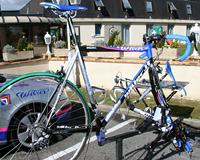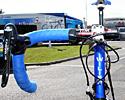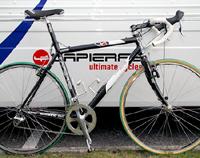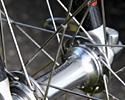
Recently on Cyclingnews.com |
The bikes of Hell: Alessandro Ballan's Wilier & Frédéric Guesdon's Lapierre, April 10, 2006Anthony Tan takes a look at two of the more unusual - and successful - bikes of paris-Roubaix, a steel-framed Wilier and a road-going Lapierre cyclo-cross bike.Steel is real: Alessandro Ballan's Lampre-Fondital custom Wilier
Having ridden so well since mid-February when he won the prestigious Trofeo Laigueglia, right up until the E3 Prijs-Harelbeke and Milano-San Remo, Lampre-Fondital's Alessandro Ballan form appeared to be waning ever so slightly before Sunday. But his eventual podium place showed that he still had plenty of punch and it's just possible that the bike he was riding helped keep him fresh to the bitter end of the Hell of the North. Both Ballan and former Italian cyclocross champ Franzoi were using custom-made Wilier steel bikes, instead of their normal mix of full scandium, scandium/carbon and full carbon frames. Steel frames have become extremely rare in the pro peloton, but there are times when steel's reliability is worth the extra grams. It also doesn't hurt that steel's failure mode is quite forgiving - steel tends to bend rather than snap, so a rider might be able to continue on a steel frame after a crash that would destroy a carbon or aluminium. Lampre's chief mechanic told Cyclingnews that these special frames for Roubaix are one centimetre longer both in the front and back, adding two centimetres to the wheelbase and increasing comfort and stability. Furthermore, the 32-spoke hand-built wheels will be paired with 27mm Vittoria tubulars both front and rear; depending on rider preference, tyre pressure will range from six to seven bars. Add a double wrapping of bar tape and Bob's your Uncle!
Chef Marjet's Lapierre delight: Frédéric Guesdon's Française des Jeux Lapierre
Perhaps the most unusual of all the bikes seen in Compiègne before the start of Paris-Roubaix, 1997 champion Frédéric Guesdon's Lapierre resembles more a cyclo-cross bike than a road machine. That's because, at heart, that's exactly what it is. Mechanic Jacques Marjet's home-cooked recipe begins by taking one cyclo-cross frame, and mixing in two cantilever brakes. You then throw in a pair of 32 spoke hand-built wheels with soldered spokes, then sprinkle with Vittoria's pavé tubulars. Race over 259 kilometres with 57.2 clicks of cobbles for six hours at less than 10 degrees C. Other teams have experimented with adding cantilever brakes to road frames for Paris-Roubaix, but the big advantage of starting with a pukka cyclo-cross frame is that you get nott only the extra mud clearance of the brakes, but lots of extra space around the wheels too. Even if wet weather isn't a factor, that extra clearance is nice to have if a rider crashes and buckles a wheel - he might be able to carry on with damage that would jam the wheel in a conventional frame. Chef Marjet's recipe cooked up a tasty treat for Guesdon and his team-mates. He finished seventh, Bernhard Eisel was fifth and Christophe Mengin came in ninth, making FdJ the only team with three riders in the top ten. It's actually a custom frame
|
|
|
|
|
Photography
For a thumbnail gallery of these images, click here
Images by Anthony Tan/Cyclingnews.com
- Steel is real - Alessandro Ballan's Lampre-Fondital cr-mo Wilier.
- An slightly oversized top tube.
- And a tapered downtube.
- Ritchey carbon forks with extended rake for comfort.
- 31.8mmm oversized bars and stem.
- Better hurry up - Alessandro Ballan's spare bike was still in the process of being made a day before the start of Paris-Roubaix.
- The lanky though flexible Ballan sits very low when riding in the drops.
- Hmm, they're not Campagnolo brake blocks...
- Frédéric Guesdon's Lapierre - arguably the most modified of any of the bikes seen for Paris-Roubaix.
- Ritchey's WCS stem.
- Go the canti's! Rustproof they're not, but they certainly do work when the going gets tough.
- A closer look at one of the cantilever brake arms.
- Pulling the lever at the headset downwards...
- ... opens up the brakes to allow the 27mm wide tyre and front wheel to pop out for wheel changes.
- 32 hole hubs and soldered spokes - the tying and soldering helps keep the wheel straight if a spopke breaks.
- This is actually Lapierre's aluminium cyclocross frame, modified for Roubaix.
- The rear cantilever brake - using Shimano's Deore XT mountain bike brake blocks.










